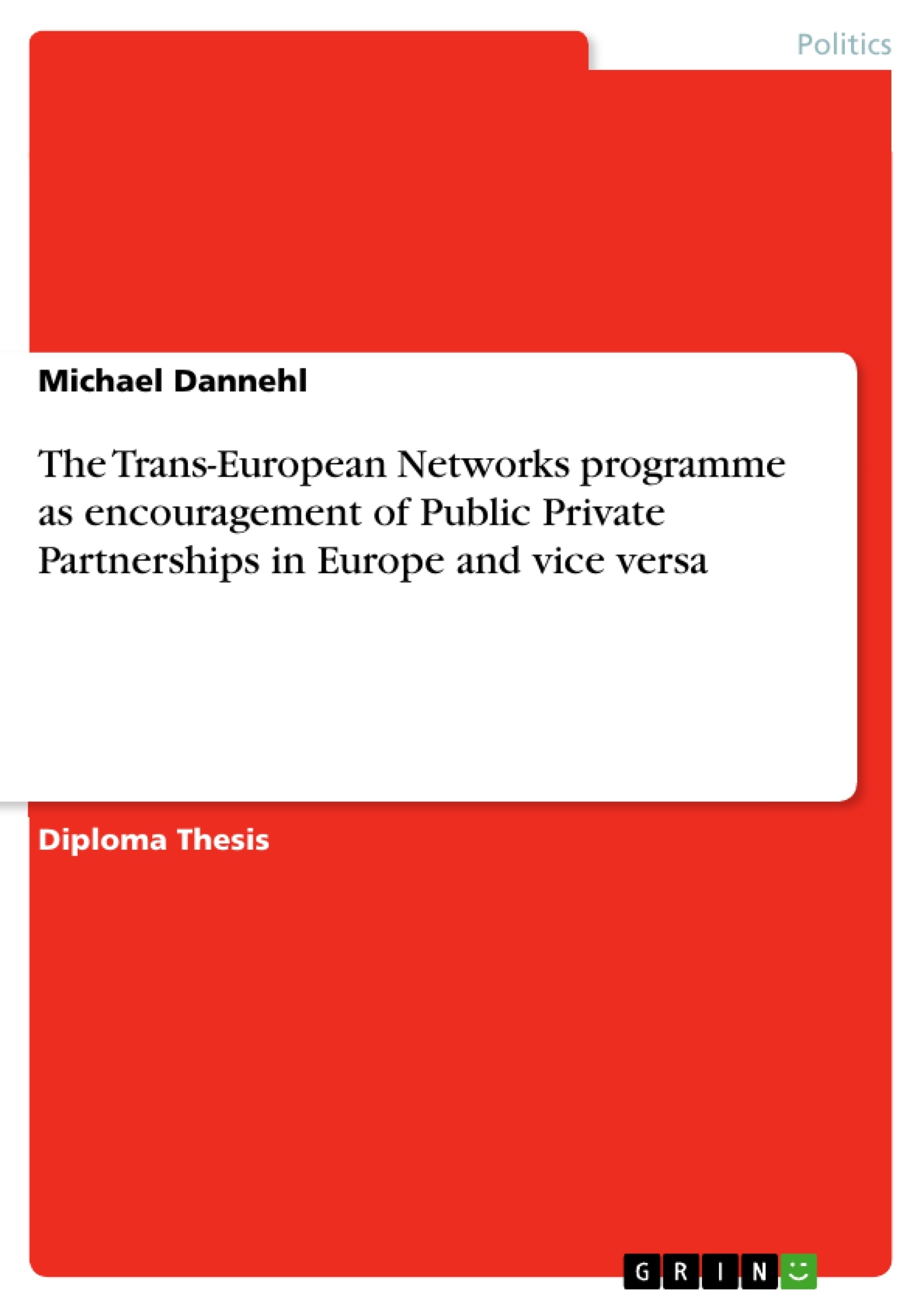The thesis at hand deals with the European programme Trans-European Networks (TEN) as support for infrastructure of a common interest for Europe in connection with Public Private Partnerships (PPPs or P3s). It will be shown that the former encourages the latter and the other way around and that this encouragement is inherent. This is also underlined by the area of applications for PPPs and TEN.
Collaborations of public and private sector are not seen as a panacea, but it will be shown that there is much more to gain then to loose from this unconventional way of implementing infrastructure projects, which become more and more important. This is especially underlined through the need of investment in Europe’s infrastructure and tight budgets of the European Union and their member states at the same time. Furthermore, the gain of additional expertise, faster realisation and cost savings through synergetic effects are normally by-products of a rather commercial orientation. However, it is also stressed that such a participation of the private sector shall be accompanied by sharing unprofitable parts of projects, even if different types of Public Private Partnerships are used within such a project. Casting a light on the Trans-European Networks programme as a pillar of European regional policy, this view is supported.
Around the world, P3s are used widely in different forms. Three examples will be presented according to the three sectors of TEN. As it is the norm, these different models leave space for inventive solutions to tackle individuality of projects. Rigid PPP structures on European level therefore are not recommended in this work. However, to deal with a variety of problems and to make use of a range of advantages at the same time, a compulsory use of Public Private Partnerships when implementing Trans-European Networks projects is advised.
Table of Contents
- Introduction and outline
- The Trans-European Networks programme
- The energy and transport policy of the European Union
- Scope of the Trans-European Networks programme
- Trans-European Transport Networks (TEN-T)
- Trans-European Energy Networks (TEN-E)
- Trans-European Telecommunications Networks (e-TEN)
- TEN approach as part of European regional policy
- Historical and background legal framework of TEN
- Projects within the TEN approach
- Financial aspects and state of TEN in the transport sector
- Public Private Partnerships
- Definition and separation from privatisation
- Scope of application and dis/advantages
- PPPs around the world
- Models of Public Private Partnerships
- The Concession Model
- Design, Build, Operate and Finance Model (DBOF)
- Consolidation of PPP and the TEN programme
- Public Private Partnership projects
- Tunnel to Rostock
- Traffic situation in Rostock
- Project procedure, tasks and legal relationship of the partners
- Model, advantages and disadvantages and financial aspects
- Berlin's traffic lights system
- Privatising traffic lights
- Project procedure, tasks and legal relationship of the partners
- Model, advantages and disadvantages and financial aspects
- The Galileo project
- Independency of Europe's telecommunication sector
- Project procedure, tasks and legal relationship of the partners
- Model, advantages and disadvantages and financial aspects
- Tunnel to Rostock
Objectives and Key Themes
This thesis examines the European programme Trans-European Networks (TEN) as a means of supporting infrastructure projects of common European interest, in conjunction with Public Private Partnerships (PPPs). It argues that these two entities mutually encourage each other and that this mutual support is inherent to their nature. The thesis analyzes the areas of application for both PPPs and TEN, and while not presented as a panacea, it highlights the potential benefits of this unconventional approach to infrastructure development, particularly in light of the increasing need for investment in Europe's infrastructure alongside constrained budgets within the European Union and its member states.
- The role of the Trans-European Networks programme in supporting infrastructure projects of common European interest.
- The advantages and disadvantages of Public Private Partnerships (PPPs) in infrastructure development.
- The relationship between the TEN programme and PPPs, and the potential for mutual encouragement.
- The use of PPPs in different sectors, with specific examples from the energy, transport, and telecommunications sectors.
- The challenges and opportunities presented by PPPs in the context of European regional policy.
Chapter Summaries
- Introduction and outline: This chapter provides an overview of the thesis, outlining the research question, objectives, and methodology.
- The Trans-European Networks programme: This chapter explores the Trans-European Networks (TEN) programme, its objectives, and its role in European energy and transport policy. It also examines the historical and legal framework of the TEN programme, as well as the specific projects implemented within the TEN approach.
- Public Private Partnerships: This chapter defines Public Private Partnerships (PPPs) and differentiates them from privatization. It discusses the scope of application of PPPs, their advantages and disadvantages, and their use in different countries around the world. The chapter also examines various models of PPPs, including the Concession Model and the Design, Build, Operate and Finance Model (DBOF).
- Public Private Partnership projects: This chapter presents three case studies of PPP projects implemented in different sectors: the Tunnel to Rostock (transport), Berlin's traffic lights system (energy), and the Galileo project (telecommunications). The chapter examines the project procedures, tasks, and legal relationships of the partners involved in each project, as well as the specific models, advantages, disadvantages, and financial aspects of each project.
Keywords
The main keywords and focus topics of this thesis include Trans-European Networks (TEN), Public Private Partnerships (PPPs), infrastructure development, European regional policy, energy and transport policy, concession models, Design, Build, Operate and Finance (DBOF) model, and case studies from the transport, energy, and telecommunications sectors.
- Quote paper
- Michael Dannehl (Author), 2006, The Trans-European Networks programme as encouragement of Public Private Partnerships in Europe and vice versa, Munich, GRIN Verlag, https://www.grin.com/document/68683



